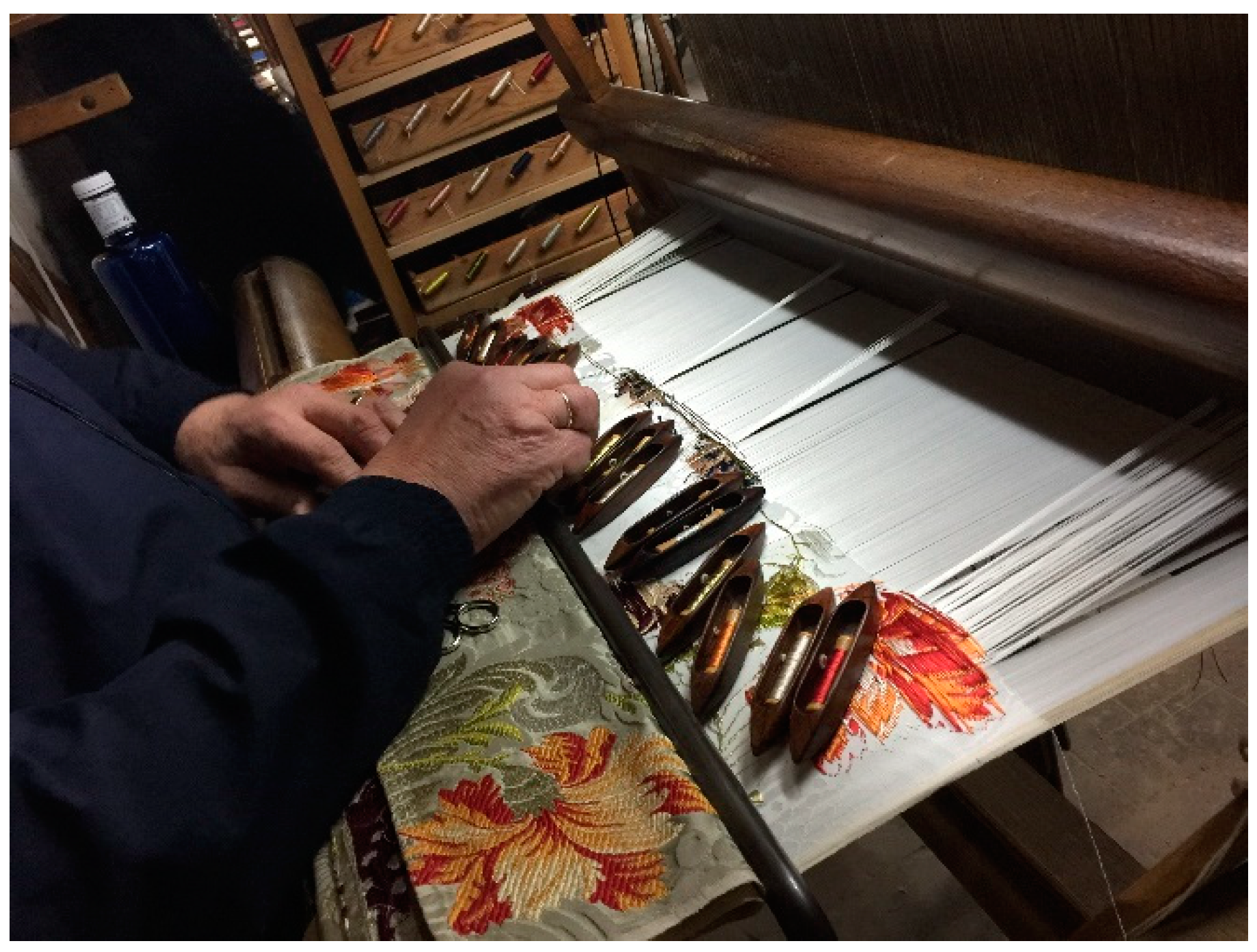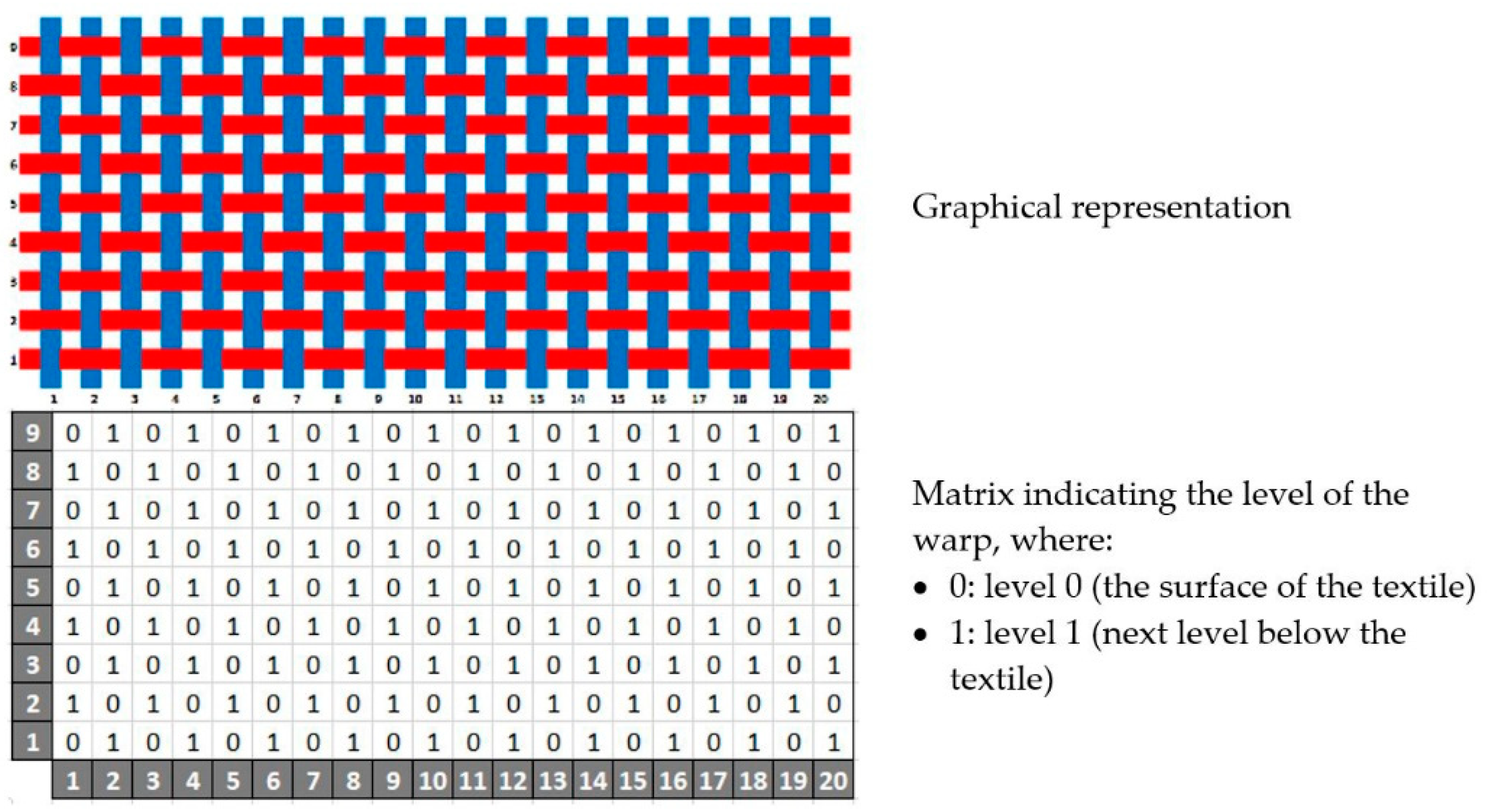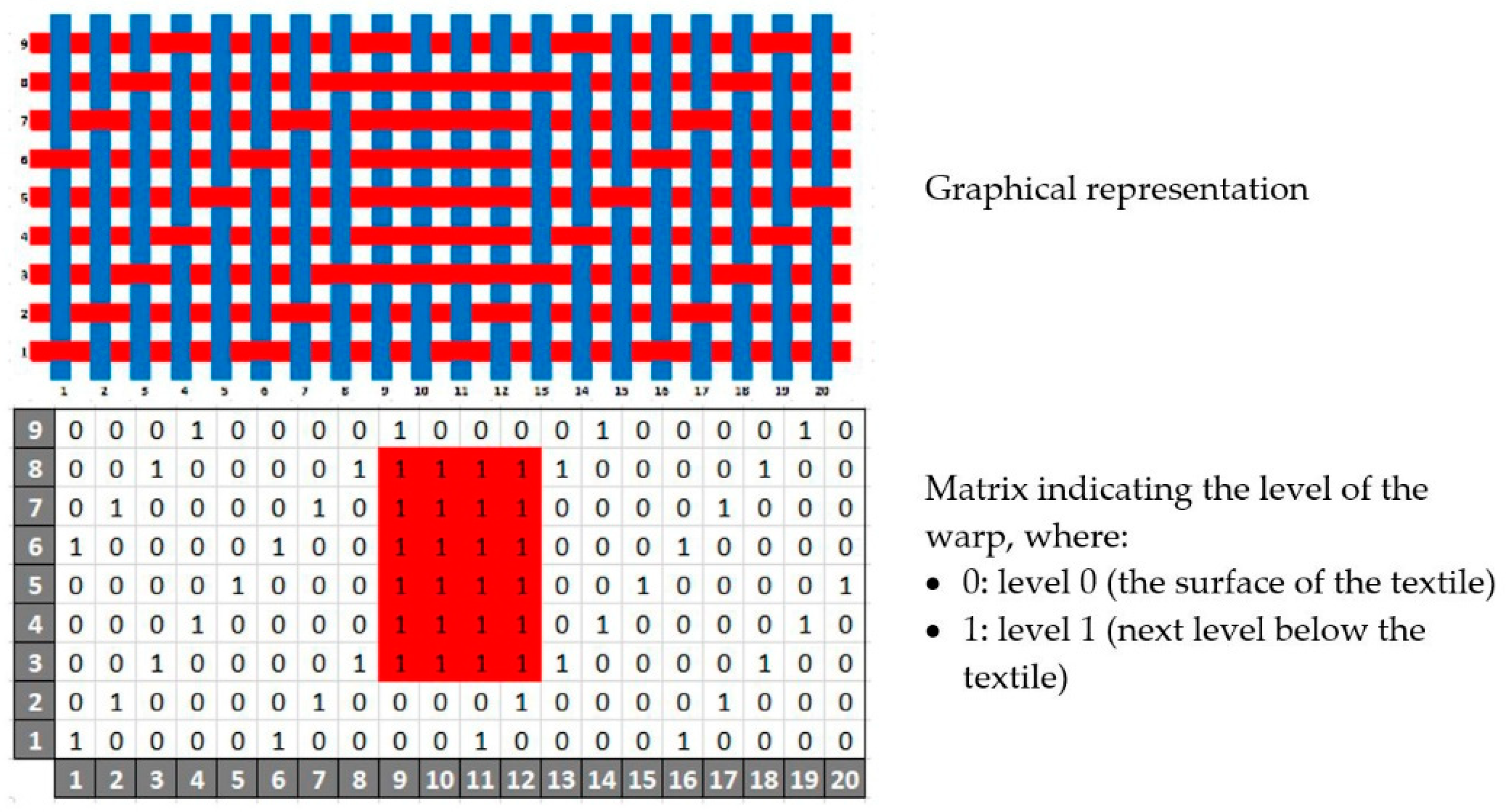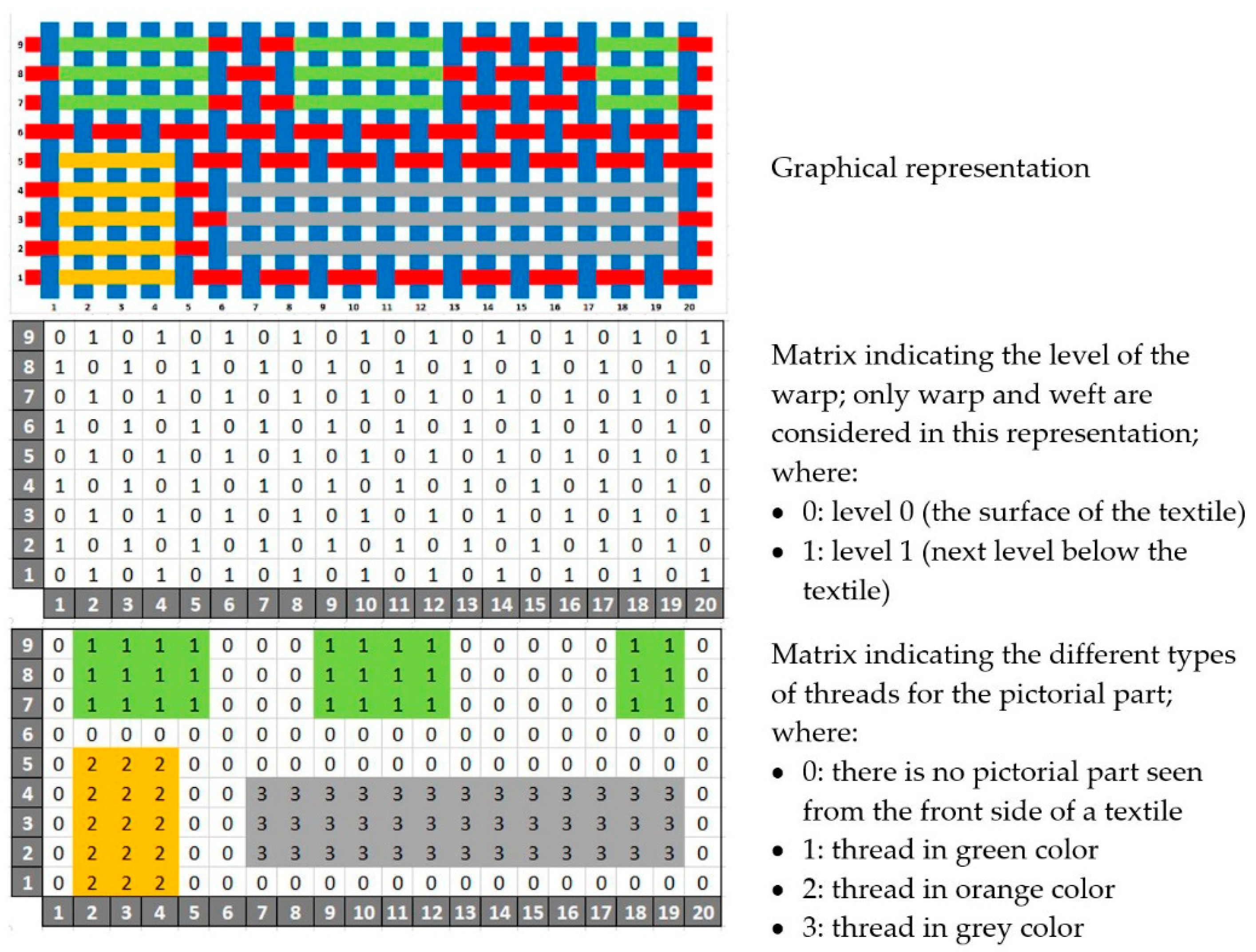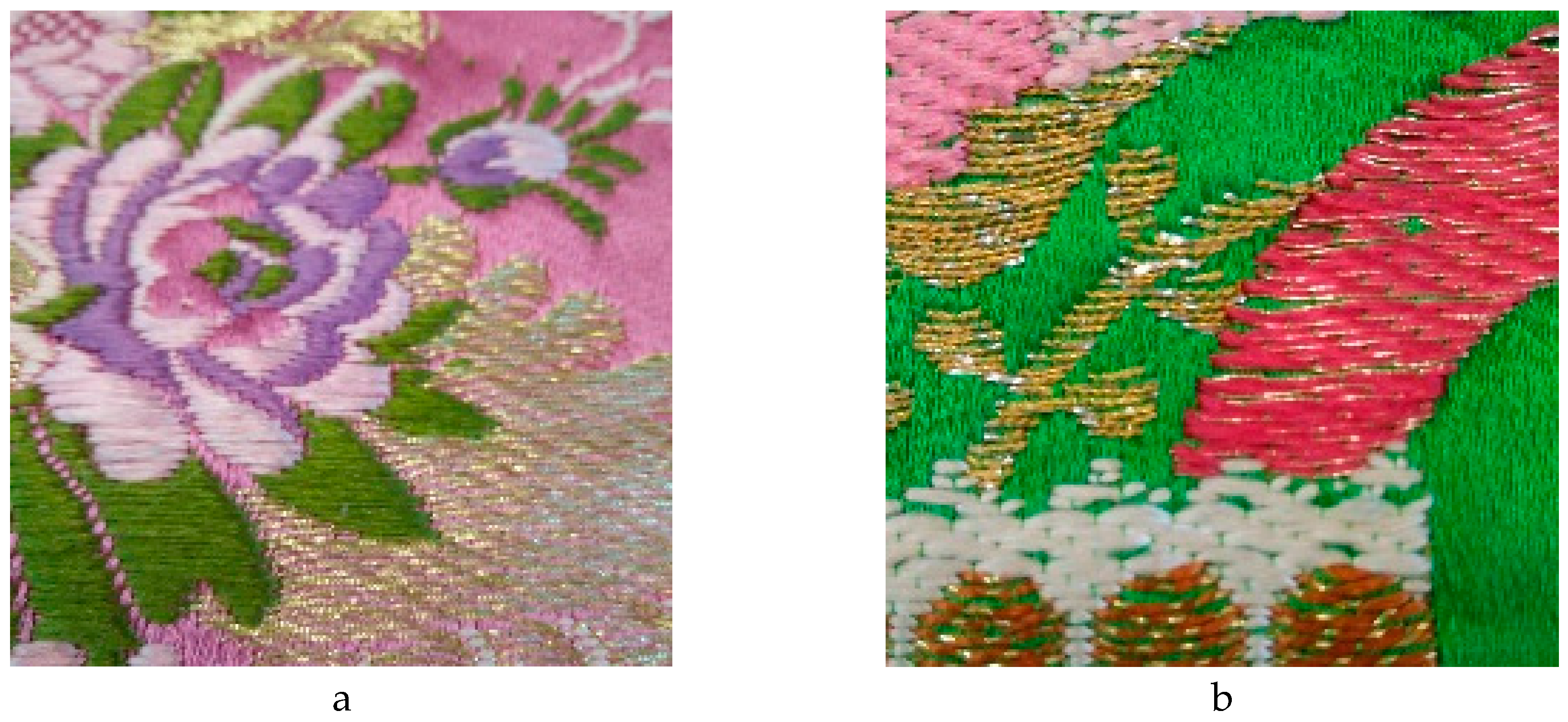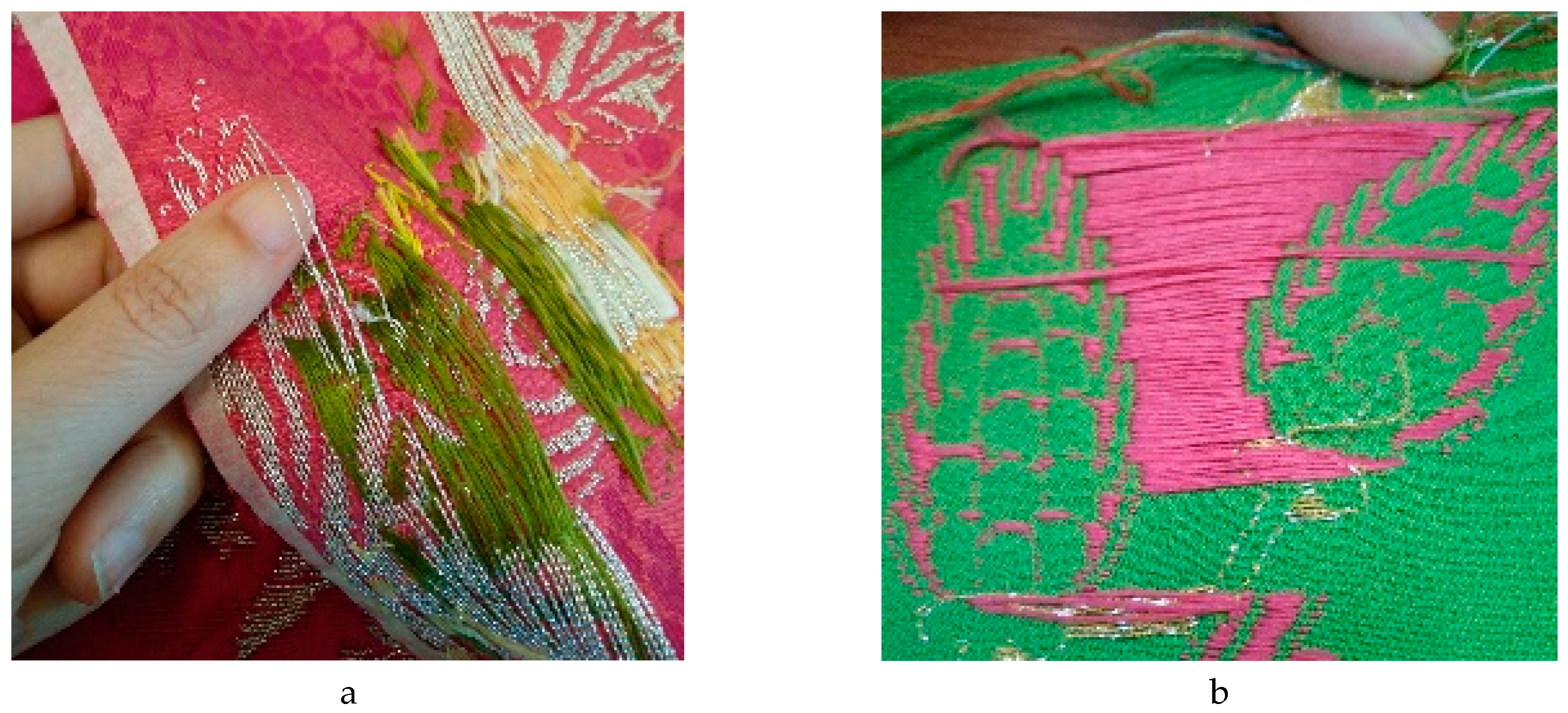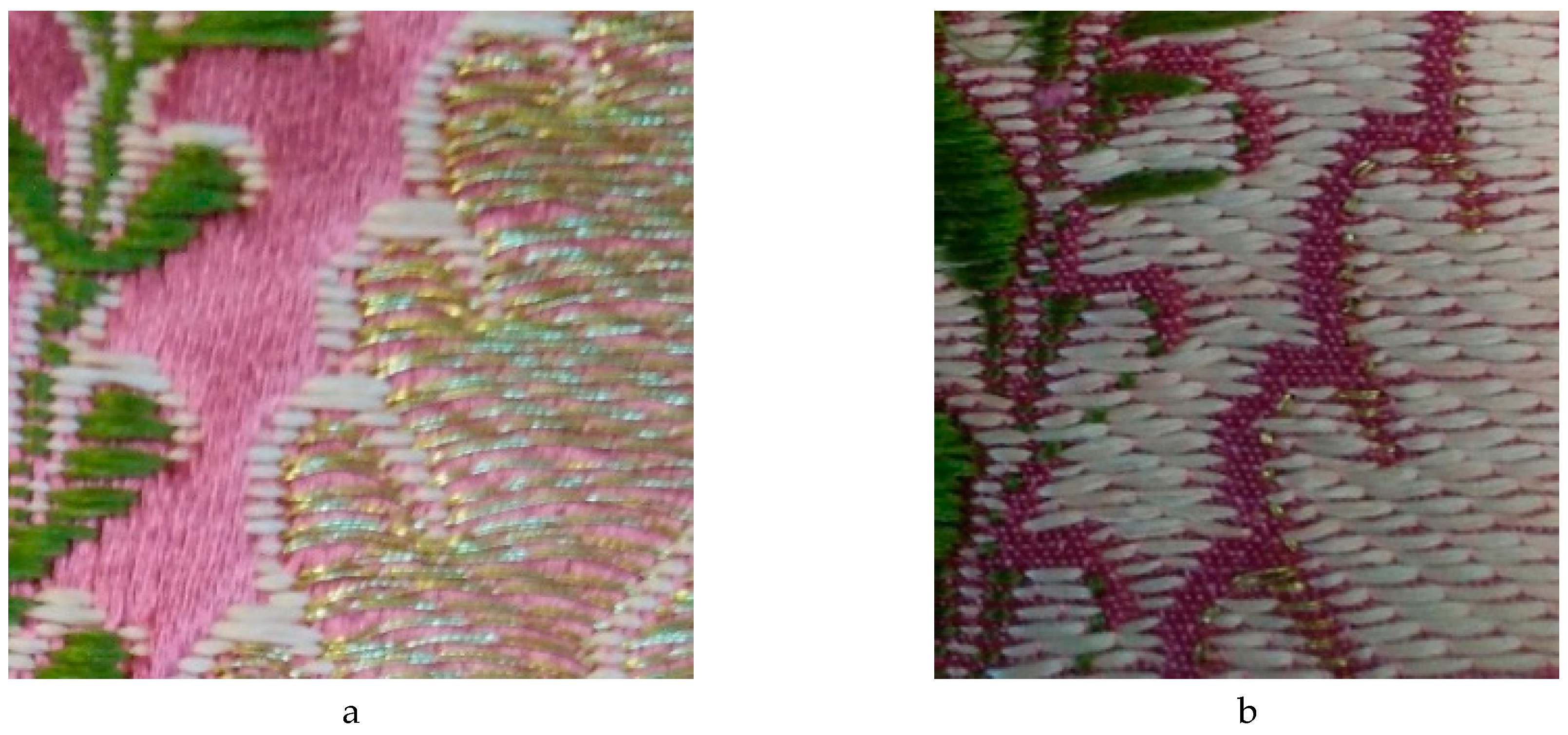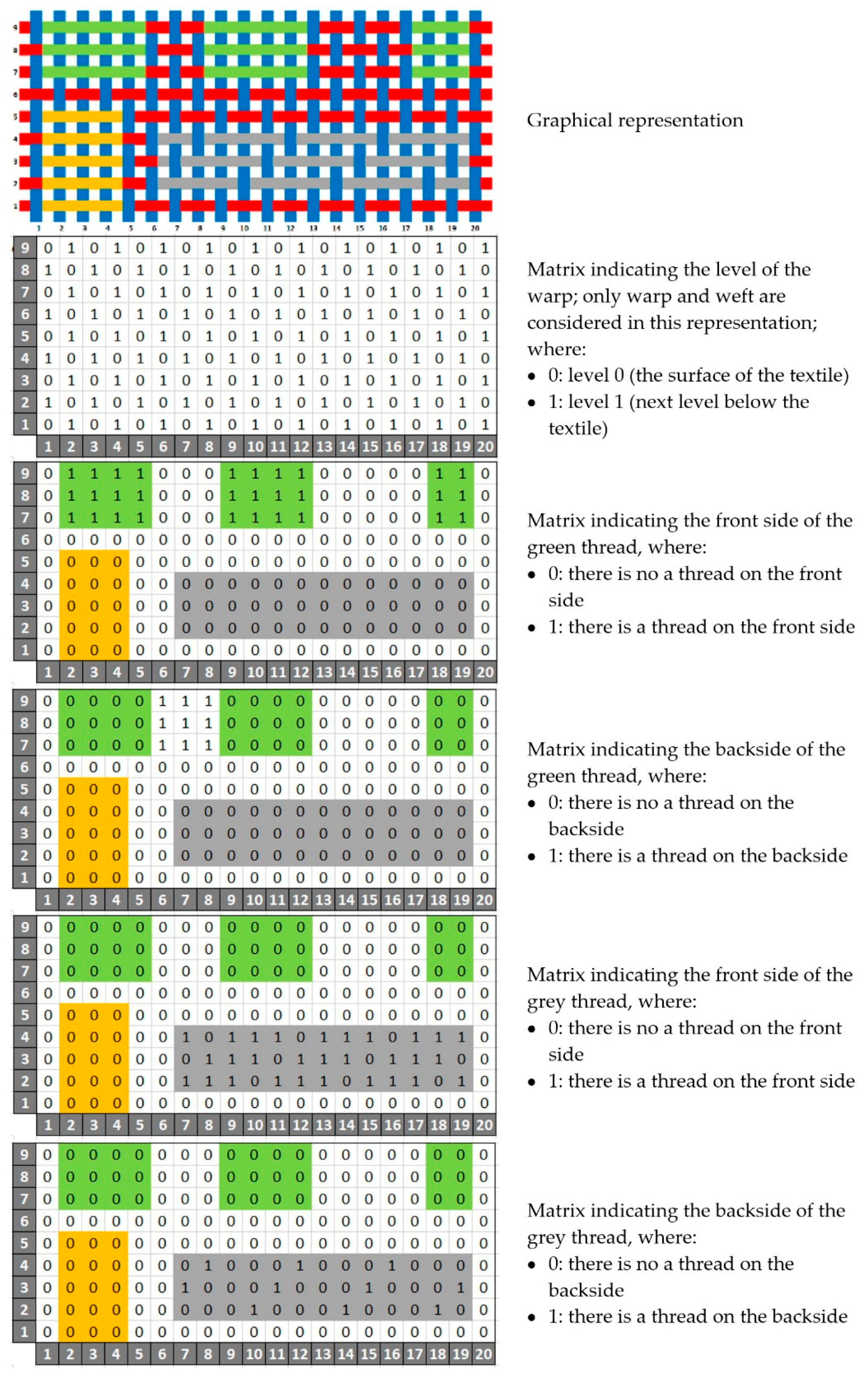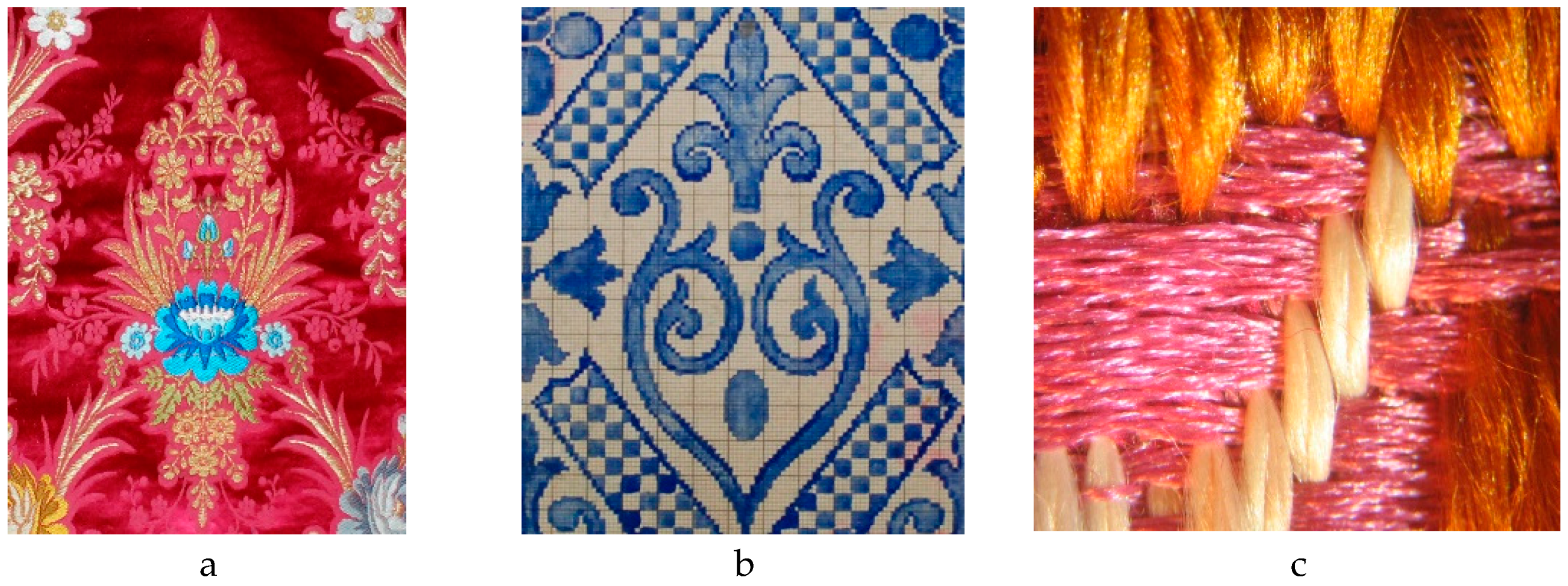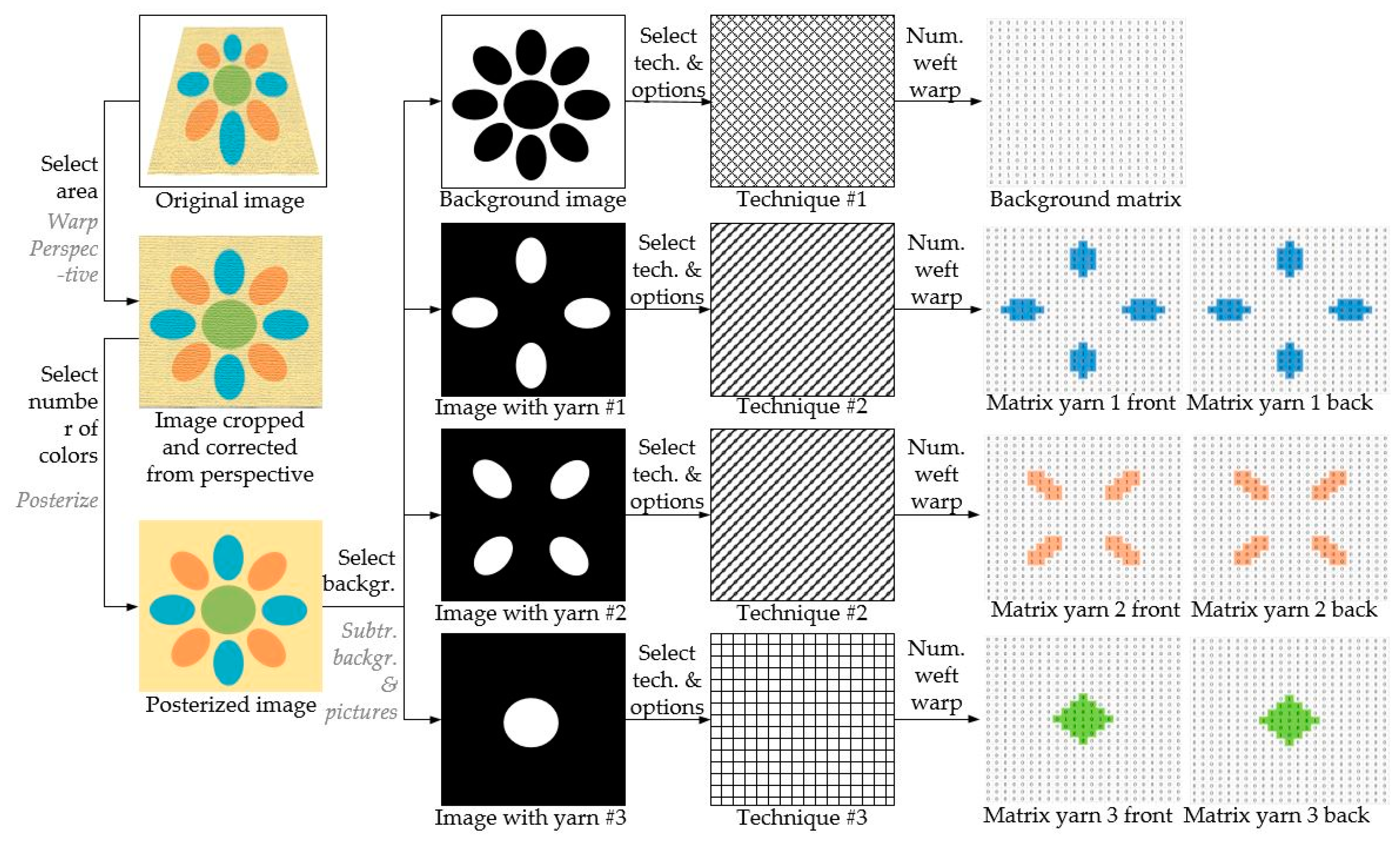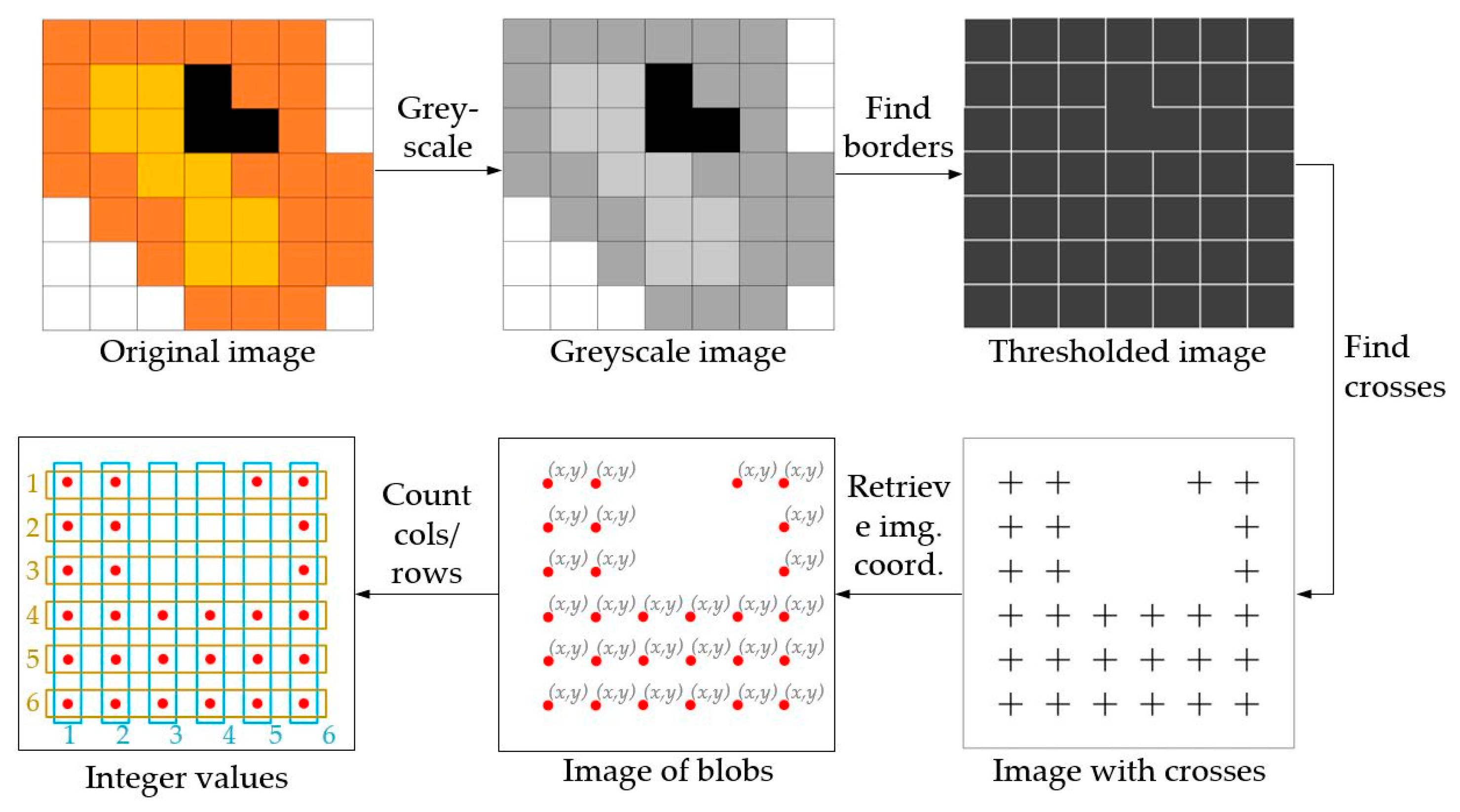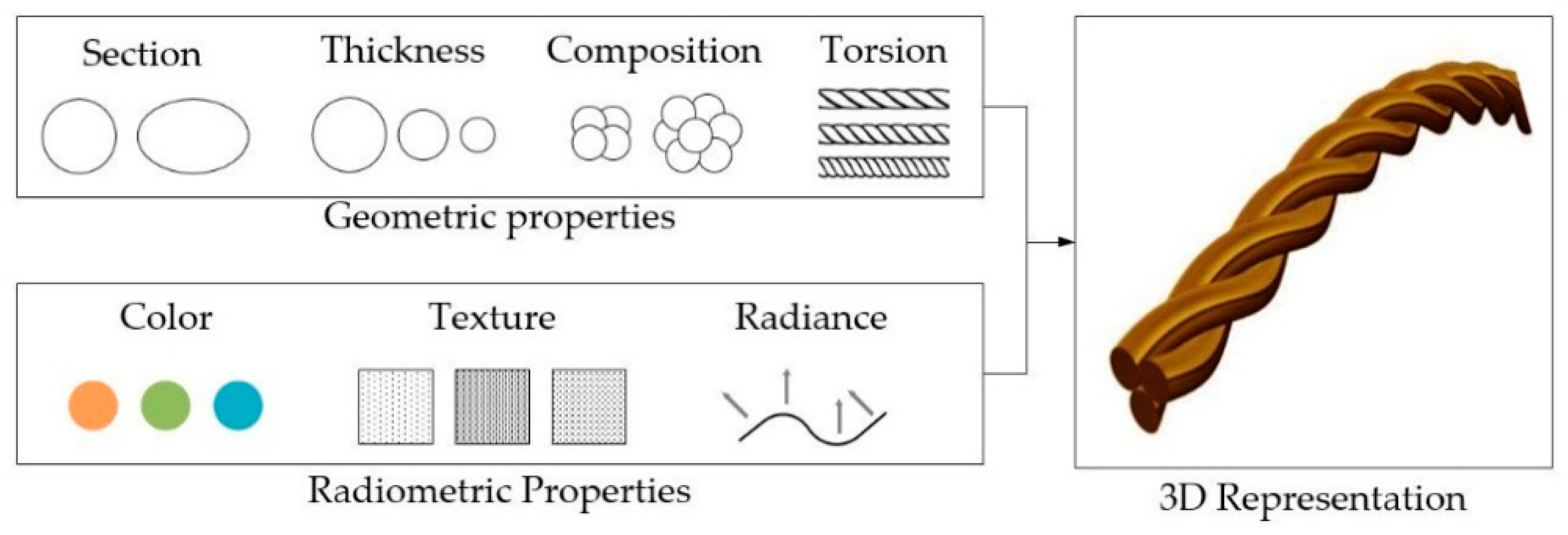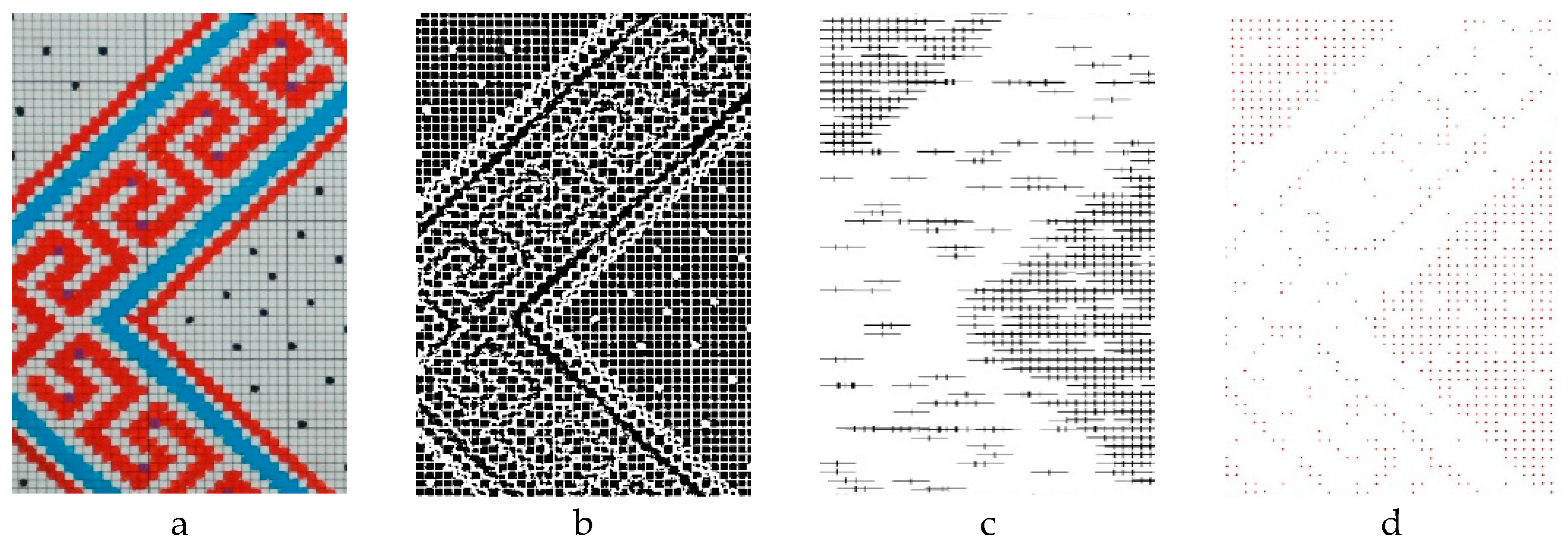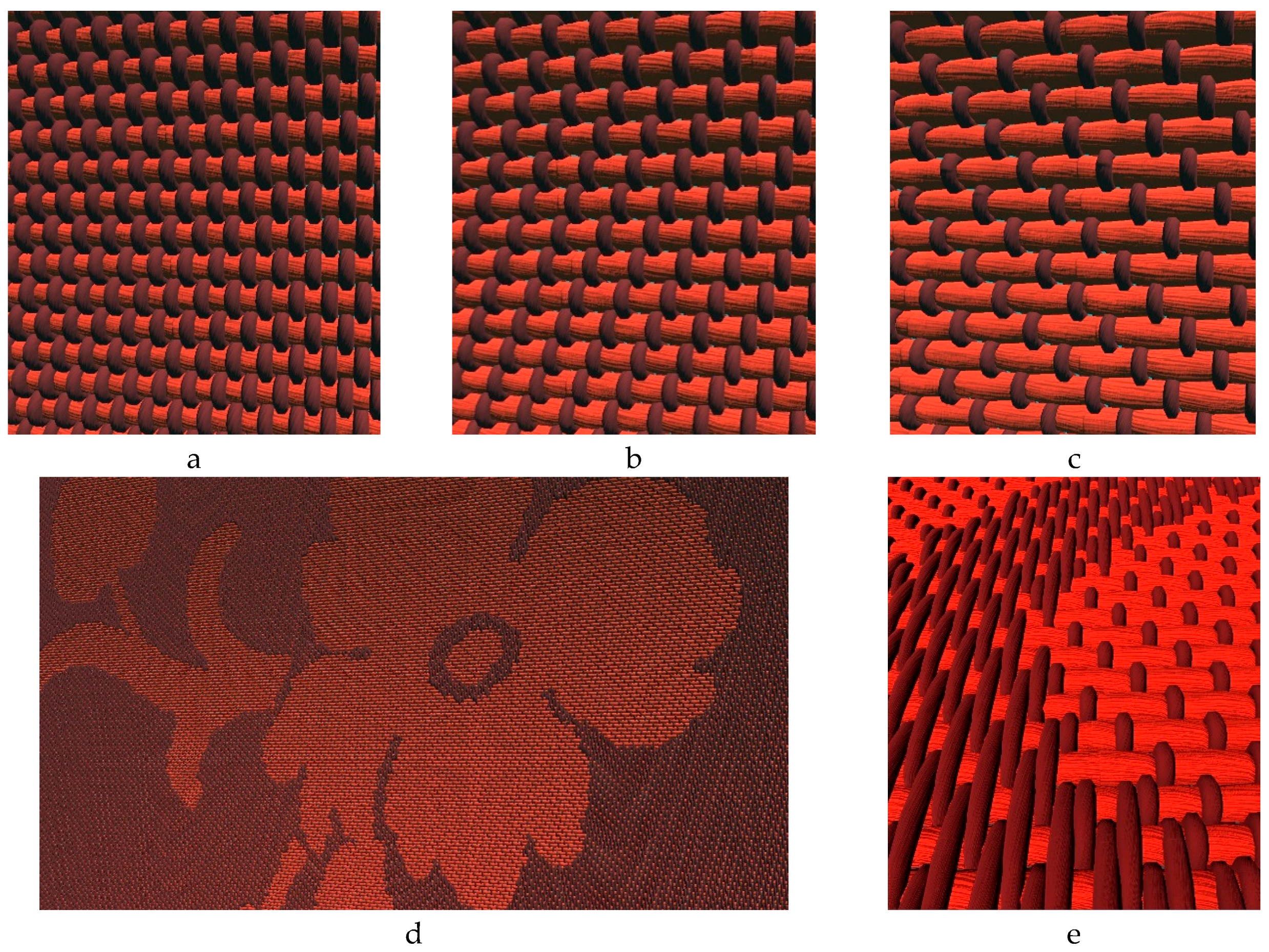1. Introduction
Textiles in general and silk in particular are part of a vast European heritage. Undeniably, European history is woven in silk. We can trace silk textiles in countless contexts, from flags to canopies, tapestries to furniture, for most of the last 2000 years. Luxury, craftsmanship, beauty and comfort have been—and still are—associated with it. It is tangible and intangible, in fact, it can be considered as the so-called integral heritage by UNESCO as it compiles crafts, traditional knowledge, traditions, materials and techniques. Few materials bring together such variety of meanings, uses, innovation and tradition in just one element. Indeed, their typological differences, their symbolic function and their hierarchical meaning are essential to understand how these textiles have been disseminated and evolved across Europe in time and space.
Nowadays, the recognition of this important heritage can be seen in the collections of the biggest European museums such as the Victoria and Albert Museum, the Museum of Costume and the Museum of Decorative Arts of Madrid, the Musée d’Arts Decoratifs in Paris, the Abbeg Foundation, The Museo del Traje in Madrid, the Musée des Tissus in Lyon, The Centre de Documentació i Museu Tèxtil de Tarrasa, the National Museum of Ceramics and Sumptuary Arts - González Martí or the Musée de Saint-Étienne. However, it also can be found in smaller and medium-sized ecclesiastical museums, or even in parishes and cathedrals. However, silk textiles have become a seriously endangered heritage, although many European specialized institutions are in operation, they usually lack resources to develop the state-of-the-art digital resources, having as result the loss of these fabrics and even the historical techniques associated to it.
Therefore, conservation of silk textiles becomes a challenge. One reason lies on their very physical nature, more fragile than other, more conventional cultural assets such as paintings or sculptures. Another reason is their intangible dimension that makes old weaving techniques to be in danger of disappearing with the imminent closure of the very few companies that still make use of these machines. Knowing the internal structure of textiles is of relevance for a variety of areas, such as fashion, industry, education or conservation of cultural heritage. For creative industries, knowing the internal structure will facilitate them to be able to change the weft color without weaving a full textile, also they will be able to change the weave in order to see the effects produced in the textile without wasting yarn. For conservators, knowing the internal structure of a textile allows to apply different conservation methods, in this sense, approaching it without applying a destructive test is essential in order to better preserve it. Finally, if this type of heritage is well conserved it will be better-known by promoting wider access for the general public to the fragile silk heritage safeguarded in museums storages. This will lead towards a participatory conservation-oriented approach to silk heritage preservation, offering common points to engage with several stakeholders for a better understanding to preserve traditional crafts improving intangible values as well as strengthening the integration of the community.
On the other hand, historical weaving techniques have rapidly evolved in time and space and are not always easy to distinguish without a technical analysis [
1], as weaves produce structures of different appearances. In fact, the number of weaves that can be combined is almost unlimited, but in general they are derived from the basic ones: Tabby, twill and satin. Textiles inherently comprise a detailed and sequentially ordered production record. Hence, historical textiles stand out as cultural assets that need new approaches to technical analysis [
2]. However, many of the historical silk weaving techniques cannot be reproduced with standard software solutions, which are usually aligned with the characteristics of modern, mechanical looms. For example, the spines that weave the handlooms cannot be reproduced on modern looms. This is because the wefts representing pictorial parts in these historical fabrics are centered in certain places (prepared by the weaver), while the mechanical looms go automatic and pass their plots from side to side of the fabric. A good example of this can be seen in
Figure 1, where a Valencian
espolín is depicted. Due to that, a new mathematical representation embedding these techniques is needed, that allows an easy transfer to 3D drawing tools.
Some authors have already dealt with the 3D representation textiles and/or clothes [
3,
4,
5,
6], although not all of them deal with the internal structure of textiles at the yarn level. A good example is the work presented in [
5], where a representation of knitted cloth at the yarn level is proposed, which treats yarn–yarn contacts as persistent, avoiding expensive contact handling altogether. On the other hand, there also exist a variety of software for the 3D virtual representation of textiles, such as WiseTex [
7,
8] or TexGen [
9]. The WiseTex software suite is an integrated tool for modeling textiles and textile composites, embedding a variety of software modules for the internal geometry, the virtual reality visualisation, the resistance of textiles to tension, shear and compaction, etc. On the other hand, TexGen allows modelling the geometry of textile structures with a variety of properties, including textile mechanics, permeability and composite mechanical behavior.
The aim of this paper is to propose a basic mathematical representation of historical weaving techniques, focusing on historical silk textiles, ranging from the 15th to the 19th centuries. We also propose a computer vision-based strategy to extract relevant information from digital imagery, by considering different types of images.
The work here presented has been carried out in the scope of SILKNOW [
10] an three-year project (2018–2021) that aims at preserving silk digital heritage. The project has been funded by the EU’s Horizon 2020 Programme under the two-stage call SC6-CULT-COOP-09. It is coordinated by the Universitat de València by means of an interdisciplinary team composed by the Institute of Robotics and Information and Communication Technologies (IRTIC) and the Faculty of Geography and History. The partnership comprises of three universities, three research institutes, an international institution and a traditional and a high-tech textile SMEs, from six EU countries. Among the partnership, different areas of knowledge are covered, including text analytics, image processing, interactive graphics, semantics, big data, 3D printing, art history, terminology, textile fabrication and conservation.
Finally, yet importantly, it is worth mentioning that the work here presented corresponds to an ongoing project, and some variations may be included in the final solution.
2. Silk: A European Heritage. The Evolution of Weaving Techniques and Designs
2.1. The Spread of Silk Weaving Techniques Across Europe
The technological transfer through the Silk Road must be approached from a transcultural perspective, emphasizing the reciprocal exchanges established between Asia, America and Europe, and not only from just a single point of view [
11]. In fact, designs and methods were widely and rapidly transferred in production centers along centuries, creating a European shared frame of themes and techniques [
1,
2], reaching its biggest development in the 18th century. During the Middle Ages, Italian powers played an important role in the transfer of technology and decorative designs, which over time resulted in the birth of the Italian textile industry. That is why, since the thirteenth century silk important centers began to emerge in Italy, such as Lucca, Florence and later Milan, Genoa and Venice. During the 14th century, an important nucleus of artisans was settled in the cities, eventually leading to the establishment of proper neighborhoods from the 14th to the 18th centuries (Velluters in Valencia, Soirie or Croix Rousse in Lyon, San Leucio, etc.). The variety of fabrics promoted by these artisans corresponded to a new luxurious silk fashion that had arrived in Europe during the Middle Ages, especially since the 14th century. These fabrics had more than one weft or warp and multiple weaves derived from the main combinations. Some of them were made only in silk (the most luxurious ones) while other were combined with other fabrics such as linen, or wool, and later hemp or cotton among others. Other techniques such as lampas or damask, were developed [
1]. While on the 15th century the techniques were enriched and made velvets [
12] one of the most favourites ones. These beginnings will give rise, from the mid-seventeenth century, to textile centers of first magnitude such as Lyon, or Tours where in the mid-sixteenth century, we can already find a new silk taffeta called gro de Tours [
12].
The 18th century should be considered as the golden age of European silk, with Lyon leading textile production and innovative designs [
13]. The
Lyonnais model will enhance the diffusion of French fashion, especially in the territories that were dominated by the Bourbon dynasty, as in Spain, Naples and Sicily. Under the lights of the Enlightenment and encouraged from the Court, Royal industries arose both thanks to their interest in promoting industry and to the concept of useful arts that Anton Rafael Mengs introduced in European courts, especially in the Spanish court. One of the most significant cases is the
Real Fábrica de la seda in Valencia under the sponsorship of the monarchy of Charles III of Bourbon [
14], which followed the
lyonnais production systems. At the School of Flowers and Ornaments, students were introduced into the learning of drawing and design of floral patterns, decorations
all’antica, as well as compositions made by their teachers [
15,
16]. However, the most important legacy of the Academy was the system itself that would be inherited by silk industries that began to proliferate in the early 19th century in the Valencian area, where many of them are still active today, as Garín, Catalá or Camilo Miralles that together with the introduction of Jacquard looms revolutionized silk industry [
17]. This story is interlaced with the establishment of the Real Colonia Serica di San Leucio, a royal silk factory that King Ferdinand IV erected in 1778, not far from the royal palace of Caserta (Naples). This industry remained open until 1861, when, after the invasion of the Savoy, the Kingdom was annexed to Piedmont and the industry was privatized. Nevertheless, the workers decided to open a small family business, that still operates under the
Consorzio San Leucio Seta:
Setica Cicala, l’Antico Opificio Serico De Negri, Industrie Tessili Alois, Manifattura Tessile Boccia, Alois, Passamanerie San Leucio, Art Mushroom Alois and Giuseppe De Negri e Figli.
During the same century, and due to the growing industrialization, the textile manufactures constituted a system in order to transmit the complex and necessary operations that were needed to make a fabric in a graphic and codified way. The invention of these codes (still used nowadays) is attributed to Jean Revel (1684–1751) around 1750, a painter linked to the silk industry in Lyon. In 1771 the same coding appears in a method created by Johann Michael Kirschbaum (1725–1782). We can say that the textile design converts the weaving project into an encoded image that explains the interweaving between the warp and the weft [
18].
Finally, at the beginning of the 19th century, the Jacquard loom revolutionized the way of producing fabrics and craftsmen’s work as it supposed the semi-mechanization of weaving. Jacquard looms facilitated to produce a bigger drawing that could be as wide as the loom width, moreover it introduces a second phase of abstraction, the binary textile/warp binary code which is transferred to the empty/full card or cardboard. With this innovation, the possibility of repeating a design became much easier and faster. Additionally, the fabrics turned from being unique pieces valued as works of art to become easily reproducible pieces.
2.2. Models and Designs from the Academies
To establish an evolution of canonical systems applied to textile designs results in an incomplete and fragmentary research, given the different origins and models of these designs, especially when they are spread across Europe. The use of ICT technologies together with the research of historians (whose research is focused on commercial relations, archives and institutions linked to silk production) and art historians (whose research is focused on design and artistic evolution of fabrics, designs and motifs) could help us to solve those enigmas. The use of mathematical models can lead to the recovery of old weaving techniques through image recognition and the knowledge of internal structure of textiles. In this sense, the mathematical relations arranged in series and the repetitive application of design models (either in symmetric or asymmetric compositions) applied to textiles (better kwon as rapport:
A unit composed of one or more motifs which, by repetition constitute the pattern of a textile) [
19] could be known.
Thus, the technical seriation of medieval images can help us to better understand the production processes based on the repetition of contents [
20]. Small designs (baskets, birds, flowers or pineapples) are repeated according to a geometric pattern or rapport. During the 15th century, the creation of designs especially made to be woven in silk made by recognized artists, such as Bellini’s album preserved in the Louvre or in the portrait of Eleonor de Toledo painted by Bronzino [
12]. As Germán Navarro mentions [
11], the Italian and Spanish decorative patterns were absolutely similar and repetitive, especially taking into account the transfer of technology promoted by Italian artisans and merchants to Spain, France or other European countries during the 15th and 16th centuries. This makes extremely complicated to affirm that a fabric was produced in a specific country, or even to accurately date them due to the permanence of identical decorative motifs for decades.
On the other hand, from an iconographic point of view, designs evolved according to the artistic taste of each period [
21,
22]. Thus, during the 15th and 16th centuries, in ecclesiastical fabrics we can find embroidery images, whereas velvet and metallic brocades with small designs will be common in civilian clothing. Towards the end of the century, “Roman” embroideries coexist with embroidery images, this roman style was based on geometric games of volutes, stems, fruit bowls, jugs, fantastic animals, etc. Medallions will be transformed into cartouches and the embroidery of imagery will gradually disappear, by slowly introducing the embroidered Baroque decoration. It is from the second half of the 17th century, when the silk colored flowers embroidery will occupy all the space in liturgical fabrics. During the 18th century this tendency will continue, although it will be accentuated by using asymmetrical floral subjects, especially used in women’s clothes. The 19th century, floral models were exploited, and by the end of the century, these designs will introduce some elements of oriental influence, specifically Japanese, and aesthetically based on the nature according to the modernism style.
The Academies of Fine Arts, together with the Jacquard loom allowed to generate new and diverse designs. The teaching system implied copying directly from nature during the months of spring and summer, while the rest of year, students copied archaeological models from the antiquity: Acanthus, rocailles, festoons, etc.; or specifically grotesques or the Renaissance lodges of Rafael de Urbino. In Spain, it was also usual to be inspired by the archaeological remains of Pompeii and Herculaneum through the copy of the models recorded at La Pitture antiche d’Ercolano e contorni: Incise con qualche spriegazione (Napoli, 1757) of Ottavio Antonio Baiardi, under the patronage of Carlos III himself.
It was on the 19th century when textile design studies were permanently separated from the Academies and they became Schools of Arts and Crafts and, later just Design schools. These European institutions still maintain a rich and extensive collection of mise-en-carte that, in the 20th century, were acquired in Lyon, Barcelona, Venice and other Italian cities, and especially in the English textile industry, which is extremely linked to the arts and crafts movement, as well as to the modernism. From that moment, models used came from different sources, among them it is worth mentioning the one from Désiré Guilmard, entitled Les Maitres ornemantistes. Dessinateurs, Peintres, Architectes, Sculpteurs et Graveurs. Ecoles Francaise, Itallienne, Allemande et des Pays-Bas (Flamande & Hollandaise), published in Paris in 1880. From that moment on, multitude of teaching methods and ornamental designs emerged , such as the Colección de modelos para la enseñanza del dibujo. Aplicable a las Artes, Oficios e Industrias (c. 1869) of Jaume Serra i Gilbert, which taught floral motifs. These works were followed by a large list of specialized titles in botany applied to ornamentation, such as the book by Despois de Folleville, Botanique de l’ornemantiste. L’ornement par la nature. Première partie- Dessins d’après nature. Deuxième partie. Interprétations. Compositions (Paris, 1882) However, the most significant work was the work of Eugène Grasset, professor at l’École Guérin, La plante et ses applications ornementales (Paris, 1896).
In the 20th century, the industrial application of decorative motifs, especially the botanical one will be especially used. Of special interest are:
Le décor par plant. Théorie décorative et applications industrielles. 685 sketch or dessins exécutés par l’auteur (Paris, 1904) from Alfred Keller, and
Étude de la Plante.
Son application aux industries d´art: pochoir. Papier peint. Étoffes. Cerámique. Marqueterie. Tapis. Ferronnerie. Reliure. Dentelles. Broderies. Vitrail. Mosaïque. Bijouterie. Orfévrerie (1908), by Maurice Pillard Verneuil, which establishes the use of decorative motifs into several applied arts. These manuals will be completed by some English ones:
Nature and Ornament, which consists of two volumes,
Nature, the raw material of Design (1908); and
Ornament, the finished product of design (1909), published in London, and
the Grammar of Ornament (1856) by Owen Jones [
21].
In these examples, the representation of these motifs implied the need to apply a series of parameters that necessary means to represent the design from different perspectives. This process implies to geometrize the nature by applying symmetry to these motifs. This process is more evident at the mises-en-carte, especially on the Jacquard system.
4. Representation of Historical Weaving Techniques
“We may say most aptly that the Analytical Engine weaves algebraical patterns just as the Jacquard-loom weaves flowers and leaves”. Ada Lovelace used this quote to describe Charles Babbage’s Analytical Engine, the first know-machine to tabulate polynomial functions. However, as Ellen Harlizius-Klück describes in [
33], Jacquard was not the inventor of algebraic patterns, but the first to make the binary basis of weaving known and understandable for non-weavers. In fact, as we sated previously, weaving had always applied mathematical principles to its creations.
The most essential components are the warp threads which interlace with at right angles with the weft threads, which in the majority of fabrics the order of interlacement repeats periodically across the fabric in both weft-ways and warp-ways directions [
34]. The system of interlacing the threads of warp and weft according to defined rules in order to produce all or part of a textile is called weave [
19]. The smallest, individual recurring part is a repeat, which must have at least two interlacements [
35]. Numerous sequences of interlacements can be done forming simple structures (they only have on weave and can be divided in fundamentals or derivatives) or compound ones (they are made by the combination of one weave or for more than two simple or different weaves). The evolution of these techniques had evolved from region to region and from period to period giving as result fabrics with different properties and aesthetical characteristics [
35]. These techniques and tastes were distributed thanks to different knowledge and sheds shared in the European Silk Road.
In order to produce fabrics, three fundamental types of textile weaves can be used: tabby, twill and satin. Tabby is the most basic of those weaves, based on a unit of two ends and two picks, in which each end passes over one and under one pick. The binding points are set over one end on successive pick [
19]. A twill is based on a unit of three or more picks, in which each end passes over two or more adjacent picks and under the next one or more, or under two or more adjacent picks and over the next one or more. The binding points are set over by one end on successive picks, and form diagonal lines [
19]. Satin is based on a unit of five or more ends, and a number of picks equal to, or a multiple of, the number of ends. Each end either passes over four or more adjacent picks and under the next one or passes under four or more adjacent picks and over the next one. The binding points are set over two or more ends on successive picks and are distributed in an unobtrusive manner to give a smooth appearance [
19].
After the discovery and evolution of these main weaves and their derivatives, a major advance was the development of decorative-weaving techniques that are embellished with weft- or warp-ways colored stripes, or through the use of supplementary threads, or by the use of metallic yarn [
35]. Some examples of figured-fabric include brocades and damasks.
Here we describe some textiles that are going to be studied in the virtual loom and their complexity:
Brocade: Silk textile weaved in a manual loom with a brocading weft, which is a supplementary weft introduced into a ground weave;
Damask: A self-pattered weave with one warp and one weft in which the pattern is formed by a contrast of binding systems. In its classic form it is reversible, and the contrast is produced by the use of the warp and weft faces of the same weave, usually satin. Most silk damasks are of unbalanced weave with a fine, closely set warp producing a shiny warp face and a heavier, more widely spaced weft giving quite a dull appearance in the areas where the weft predominates;
Taffeta: Traditionally a term used for a fine silk fabric of tabby weave;
Twill: Fabric, whose weft threads cross with those of warp in a staggered way, forming diagonal lines;
Satin: Fabric whose warp threads pass over several weft, so that those are always hidden in the right of the fabric whereas the other side shows a smooth and shiny surface;
Velvet: A warp-pile weave in which the pile is produced by a pile warp that is raised in loops above a ground weave through the introduction of rods during the weaving;
Vellut: Fuzzy velvet formed by two warps and a weft, and which was manufactured in four different varieties: vellut senar (22 weaves), vellut común (21 weaves), vellut doble (20 weaves), and vellut vellutat (any velvet that was not cut in the loom).
As seen, for the design, creation and analysis of woven fabrics, it is necessary to plan or determine the sequence of interlacements, where mathematical models can be extracted. In this sense, we introduce a strategy to deal with a basic mathematical representation of historical weaving techniques. Following other works, we base our strategy in representing yarns in form of matrices with different layers and discern between textiles that can be represented using a single matrix and those that require a multiple matrix representation. This way of representing the textiles will form the basis to build the 3D models in the Virtual Loom.
4.1. Single Matrix Representation
In
Figure 2, the representation of a basic weave is given, following the usual convention. As it can be seen, this example can be fully represented with only one matrix. The given matrix indicates the level of the warp, with level 0 indicating the surface of the textile, and the level 1 indicating the level below the textile. As the threads interact one with other, the wefts lay just in the other level: When a warp is in level 0, the weft is in level 1 and the other way round. The example shown in
Figure 2 corresponds to a plain weave or tabby. Other basic weaves are twill and satin, which can also be represented using this convention.
In
Figure 3 an example is shown for a
damask, a technique that has a pictorial part, although it involves only one layer of warps and one layer of wefts, and therefore the representation of a damask can also be done with a single matrix. Note that the area where the pictorial part has been represented (in form of a square) is highlighted in red in the matrix just to highlight this fact.
4.2. Multiple Matrix Representation
Matricial forms can also be used to represent complex weavings involving different layers, as suggested by [
36,
37], where the topological coding of a multilayered weave is based on warp yarns paths. The
ith warp path is coded by a sequence of intersection levels
wij denoting either the index number of the weft layer situated above the warp yarn in its intersection with the
jth weft row, or 0 if the warp yarn lies on the face of the fabric. With this kind of representation, only one matrix is used.
However, for the representation of historical silk textiles more than one matrix is needed. This is because the yarns representing pictorial parts in these historical fabrics are centered in certain places (prepared by the weaver), so they do not go from side to side of the fabric. As they are horizontally weaved, they are aligned with the weft yarns, but constitute an additional layer that is not homogeneous alongside with the textile.
Therefore, pictorial parts involving other threads need to be represented with additional matrices. In
Figure 4, an example with three threads forming five rectangles are shown. In this example, the background is formed of a basic weave, while the pictorial parts are on top of the background, i.e., warp and weft are always below the pictures. A straightforward way to represent this is as given in the matrices: one matrix for the background and another matrix indicating where are different types of threads.
Having a closer look to textiles, we find that there are other cases that cannot be fully represented with only two matrices. For instance: What happens with the threads of the pictorial parts on the back of the textile? How could be represented the cases where the warp interlaces the threads of pictorial parts?
After a close inspection of historical fabrics (
Figure 5,
Figure 6 and
Figure 7), it can be seen that threads of pictorial parts observed from the frontal side of a textile do not cross (e.g.,
Figure 5a,b). It might be the case that a single thread is composed of two different threads (e.g., the magenta-and-golden thread in
Figure 5b), but mathematically this can be considered as a single thread or as having a single identifier. However, threads seen from the backside of a textile might cross, as given in
Figure 6a. Also, pictorial parts of a same color that are close, can be considered as a single picture, so threads connect them at the back, as seen in
Figure 6b.
The examples shown in
Figure 6 are complex from the point of view of overlays between the threads of pictorial parts but are not that complex regarding to the fact that those threads are not interlaced with the warps. However, there are other textiles that use the technique of interlacing the thread of the pictorial parts from time to time, and this can happen in either the front or the backside of textiles. An example of this fact can be seen the pictorial parts of
Figure 5b for the front side of a textile. An example for the backside of a textile is depicted in
Figure 7b. In this last case, additionally, the thread in light pink color (representing the effect of picture’s borders in the front side), do overlay all the background of the textile (in pink color).
The different cases given in
Figure 5,
Figure 6 and
Figure 7 can be taken into account in the Virtual Loom as special cases or special finishes. For instance, given pictures with different threads, to each picture it can be assigned one or various of the different characteristics or rules:
The pictorial part is interlaced with the warp from time to time (specify step) at the front side of the textile;
The pictorial part is interlaced with the warp from time to time (specify step) at the backside of the textile;
If two pictures with a same thread are closer than a certain distance (in the horizontal axis), the threads are connected from the backside. In this case, a threshold for the distance should be specified.
These rules can be directly integrated into the programming language and form part of the variables needed for the 3D modelling. For instance, the thickness and sections of the threads can be defined, as well as the separation between threads. On the other hand, these rules can also be embedded in form of matricial representations. A complex case is given in
Figure 8. Note that the textile is a little bit different from that shown in
Figure 4, as in
Figure 8 the grey thread is interlaced with the warp from time to time. Additionally, it has been determined that two of the rectangles in green color are closer than a hypothetical threshold, and therefore the threads are connected on the backside. For the sake of brevity, the two matrices corresponding to the orange yarn have been omitted.
Representing the threads of pictorial parts independently and considering both sides of the textile, allows accounting from possible overlays on the backside. This could be done simple looking where there are “ones” for a same cell in matrices representing threads of different colors. For the 3D modelling, a logical order needs to be established to see in what level representing each thread for each cell.
As all the matrices have the same size (rows, columns), the complete representation of a textile can be in form of a hypercube with different dimensions (Di), which will be ordered in the following way:
D0: the matrix embedding the pattern or background;
D1: the matrix of the pictorial part of yarn 1, for the front side of the textile;
D2: the matrix of the pictorial part of yarn 1, for the backside of the textile;
…;
Dn−1: the matrix of the pictorial part of yarn n/2, for the front side of the textile;
Dn: the matrix of the pictorial part of yarn n/2, for the backside of the textile.
In such a way, dimensions with odd numbers embed the front side of a textile, while dimensions with even numbers embed the back part of a textile.
6. Preliminary Results
In this section, we show some results after applying the three strategies given in
Section 5.2. It is important to highlight that we are mainly extracting from the images the pictorial parts (strategies 1 and 2), as the weaving technique is acquired from the metadata related to them. The implementations to extract information from images have been carried out in Python with the use of the OpenCV library, and the code is publicly available at [
38]. On the other hand, for the strategy 3 only a visual inspection is considered to build the 3D models that embed the silk geometric and radiometric properties. These 3D graphical representations have been built in Unity 3D and will be improved in the scope of the project, in order to give them a silk-like appearance.
Strategy 1: Given an image of a textile. In
Figure 13 we show some results after applying our algorithm to extract the original design from images of textiles, which is based on the methodology depicted in
Figure 10.
In this example, a damask-like textile (same technique as a damask, but with the use of two colors) is shown, which is depicted in
Figure 13a. As it can be seen the original image presents some shadows, what is not desirable to subtract the background and pictorial parts of the image. However, as the tones are quite different (red for the background, light brown for the pictorial part), is easy to discern between the background and the pictorial part. The image in
Figure 13b has been produced by using the function
cv2.kmeans with the consideration of two clusters. With this, the processed image is composed of two plain colors, one for the background and another for the pictorial part. The image shown in
Figure 13c depicts the background (in white color). To produce this image, a function has been implemented with one of the arguments an
(x,y) value, that corresponds to one pixel of the background. The function considers all pixels having the same RGB value as that of the given
(x,y) as being part of the background.
Strategy 2: Given an image of a technical drawing of a textile. In
Figure 14 we show some results after applying our algorithm to extract the number of columns and rows from a grid of a technical drawing, that is explained above, in
Figure 11.
Figure 14a shows a detail of a technical drawing. This image was then converted to a greyscale image and then a Gaussian local threshold was applied with the function
cv2.adaptiveThreshold, leading to
Figure 14b. In this image, the borders are highlighted, so the grid is seen together with other borders belonging to the pictorial part. In order to discern between the grid and the pictorial part, in the next step we looked for crosses (vertical and horizontal lines with an intersection) of a certain size. This was achieved with a morphological operator (with the form of a cross), applying the function
cv2.getStructuringElement, which led to
Figure 14c. These crosses are of interest because, knowing their image coordinates, can easily lead to count the rows and columns. However, from this function the coordinates are not returned. Therefore, we applied a last step, by finding the blobs of the image in
Figure 14c with the function
cv2.SimpleBlobDetector, what led to
Figure 14d. In this case, we have the coordinates of the center of each blob. Ordering the list of points according to their coordinates in both directions
(x, y), we can directly derive the number of rows and columns as well as the grid step (separation between consecutive lines, in pixels), also in both directions
(dx, dy).
Strategy 3: Given a set of macro images of a textile. After conducting an optical study on silk textiles by making use of a digital microscope, we derived a set of images (as the one shown in
Figure 9c) where the details of the textiles can be observed at the yarn level. Making use of these images, different types of yarns can be modelled in Unity 3D. In
Figure 15, the 3D graphical representations at the yarn level are shown for three basic techniques (plain weave,
Figure 15a, twill,
Figure 15b and satin,
Figure 15c) and the damask-like textile (
Figure 15d,e), corresponding to a small area of the image shown in
Figure 13. With these results, we have produced a web-based application (by now, beta version) which is publicly available in [
39]. It is worth to add that we are now in the process of implementing more types of silk threads.
7. Conclusion and Future Work
Recent UNESCO studies have presented diverse formulas that point towards the industries that harbor historical, cultural and geographical heritage as an essential step for its conservation and preservation. In this new categorization, cultural heritage must be viewed as a cultural process, understood as a cultural production mode related to the cultural identity, collective memory and social and cultural values [
40]. This new approach requires a new vision on cultural heritage, which cannot be understood as isolated goods or collections, detached from the traditional knowledge, techniques or from the people who maintain it and guarantee its survival.
These approaches are especially significant in intangible heritage. We must understand that in cultural heritage the whole society must intervene and participate, as its conceptualization, appreciation and valorization is not immutable, nor static, but is in permanent construction: “not in vain it seems unfeasible to achieve the desired protection of heritage without counting on people, the people who have to be a key agent in the preservation and transmission of this legacy but who, previously, must be sensitized—and even excited and motivated—with the real value of it, awareness that, as stated above, should rest on an adequate communication process … ” [
41]. This complex and dynamic process involves a necessary action of social valorization and transmission of knowledge that will lead to the social re-knowledge of the different elements and goods that make up the cultural heritage. However, what is more important, it cannot be done with the back to the community that maintains and sustains it, true protagonists of its history.
In this sense, historical silk textiles are an endangered heritage, not only the textiles themselves, but also their weaving techniques. In order to preserve this legacy, in this paper we show a proposal to represent such techniques with matrices, which are derived after extracting information from digital imagery, including images of textiles, images of technical drawings, and images taken with a digital microscope. Depending on the type of input image, different strategies are considered.
Our proposal for representing historical techniques in matrix forms makes use of a hypercube with several dimensions, with the first one representing the background and the rest representing both the front side and the backside of textiles. Additionally, man-made decisions are considered in our implementation.
Image-based algorithms are used to extract the background and the pictorial part of images, and we are able to produce independent images containing such information. Combining these images with specific weaving techniques, results in the characterization of textiles at the yarn level.
A closer inspection to silk textiles, supported by images taken with a digital microscope, give us the opportunity to model silk yarns, taking in consideration both geometric and radiometric properties. This information, together with the mathematical models representing the weaving techniques and the pictorial parts of images, is key to build 3D models of historical silk textiles that include their internal structure.
Our next step in this regards is to improve the results we have obtained so far. We intend to add the mathematical representation of more weaving techniques, including more complex ones, such as the Valencian espolín, taking in consideration both the front side and the backside of a textile. Additionally, we are also interested in adding more models that represent silk yarns, taking in consideration both the geometric and the radiometric properties. Lastly, regarding to the graphical user interface, we are working in making it highly interactive, at the same time that keeping it as intuitive as possible in order to easy the process.
